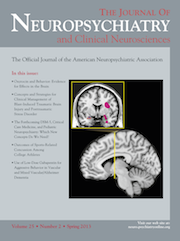Paliperidone-Induced Tardive Dystonia: A Case Report
To the Editor: Paliperidone is the principal metabolite of risperidone, and it shares the same characteristic serotonin–dopamine antagonism and receptor-binding profile.
We report on a case of a female patient who developed tardive dystonia (TD) during treatment with paliperidone, which fully subsided when she was switched to olanzapine.
Case Report
A 42-year-old woman with a 20-year history of schizophrenia was admitted to our department because of tardive dystonia that had started 2 months earlier. After her last psychotic episode, which had taken place 1 year before her admission to our clinic, she was prescribed paliperidone 6 mg per day. However, 10 months later, while still on paliperidone, she complained of a gradual onset of pain and discomfort in her neck associated with a sustained contraction of the neck muscles that would pull her head to the right in an upward direction. Clonazepam was initiated, and paliperidone was discontinued; however, the movement disorder persisted even after paliperidone discontinuation.
At admission, she presented sustained twisting movements of the neck, trunk, and upper arms, as well as intermittent, sustained facial grimacing that predominantly affected the lower face, marked retrocollis, and opisthotonic trunk extension; movement of the neck muscles was limited.
The diagnosis of antipsychotic-induced TD was established after excluding other possible causes of dystonia. She experienced minimal improvement with orphenadine. Clozapine was initiated, but this was soon discontinued because of severe sedation. Olanzapine at a dose of 10 mg daily was started, which led to remission of psychotic features; after 1 month, full recovery from the movement disorder was achieved. One year later, she remains well on olanzapine, without presenting side effects of movement.
Discussion
To our knowledge, this is the first case to describe the association of TD with paliperidone administration. TD was diagnosed based on the presence of chronic dystonia, a history of antipsychotic drug treatment preceding or concurrent with the onset of dystonia, the exclusion of known causes of secondary dystonia by appropriate clinical and laboratory evaluation, and a negative family history of dystonia.1
The potential association between paliperidone administration and TD development was established using the Naranjo algorithm.2 The patient’s adverse event appeared after paliperidone was administrated, and the adverse reaction improved when paliperidone was discontinued; there were no alternative causes that could have caused the reaction, and the adverse event improved after a specific antagonist was given.
Paliperidone’s potential for inducing TD may be mediated by its relative higher D2-receptor occupancy in the nigrostriatal pathway3 and slower dissociation from it, as compared with olanzapine.4 On the other hand, the improvement of TD with olanzapine noted in our patient may be attributed to its pharmacologic and receptor profile (greater affinity for serotonin 5-HT2 receptors than dopamine D2 receptors), which is similar to that of clozapine, while the lower blocking ability and lower affinity for D2 receptors and the rapid release from dopamine D2 receptors may be involved in the restoration of normal striatal output.5
1 : Tardive dystonia: late-onset and persistent dystonia caused by antipsychotic drugs. Neurology 1982; 32:1335–1346Crossref, Medline, Google Scholar
2 : A method for estimating the probability of adverse drug reactions. Clin Pharmacol Ther 1981; 30:239–245Crossref, Medline, Google Scholar
3 : Paliperidone for schizophrenia. Am J Health Syst Pharm 2008; 65:403–413Crossref, Medline, Google Scholar
4 : 5-HT2 and D2 receptor occupancy of olanzapine in schizophrenia: a PET investigation. Am J Psychiatry 1998; 155:921–928Crossref, Medline, Google Scholar
5 : Treatment of patients with tardive dystonia with olanzapine. Clin Neuropharmacol 2002; 25:71–74Google Scholar



